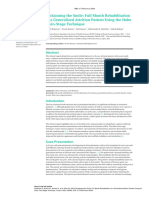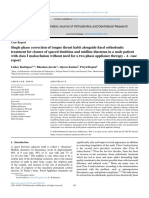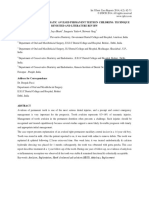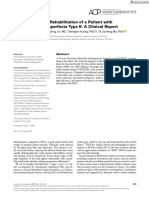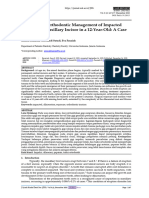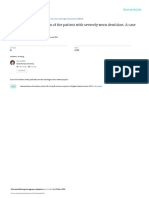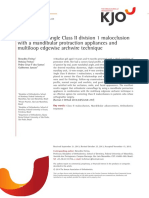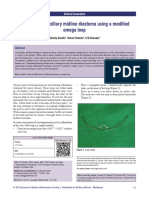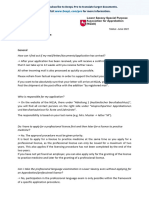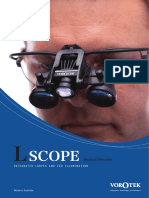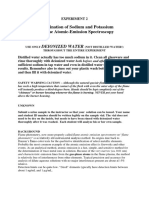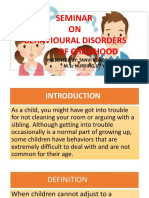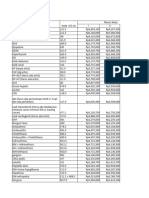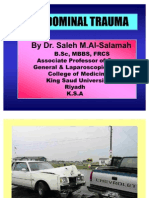311-Article Text-696-2-10-20210519
311-Article Text-696-2-10-20210519
Uploaded by
Sherweet AlsaadanyCopyright:
Available Formats
311-Article Text-696-2-10-20210519
311-Article Text-696-2-10-20210519
Uploaded by
Sherweet AlsaadanyCopyright
Available Formats
Share this document
Did you find this document useful?
Is this content inappropriate?
Copyright:
Available Formats
311-Article Text-696-2-10-20210519
311-Article Text-696-2-10-20210519
Uploaded by
Sherweet AlsaadanyCopyright:
Available Formats
Advanced Research Journal of Medical and Clinical Sciences
Received 20 Apr 2021 | Revised 4 May 2021 | Accepted 11 May 2021 | Published Online 15 May 2021
DOI: https://doi.org/10.15520/arjmcs.v7i05.311
ARJMCS 07 (05), 542−550 (2021) ISSN (O) 2455-3549 IF:1.6
ARTICLE
“Changes in Nasolabial Angle, Lip Competency And Facial Profile By
Correcting Angulation Of Maxillary Central Incisors” – A Case Report
∗
Dr. Lishoy Rodrigues 1 Dr. Shilpa Chawla Jamenis 2 Dr. Bhushan Jawale 3 Dr.
Bhagyashree Jadhav 4 Dr. Vanessa Varghese 5 Dr. Tejas Kadam 6 Dr. Chirayu Jain 7
Dr. Almas Shaikh 8
1PG Student, Dept of Orthodontics Abstract
and Dentofacial Orthopedics, Sinhgad
Dental College and Hospital, Vadgaon
This case report evaluates the management of bimaxillary dentoalveolar
Bk, Pune, Maharashtra, India protrusion in a female patient with a Class I malocclusion with conven-
2Reader,Dept of Orthodontics and
tional fixed appliance mechanotherapy. The case required extraction
Dentofacial Orthopedics, Sinhgad of 1st premolars for correction of the proclined and forwardly placed
Dental College and Hospital, upper and lower anterior teeth. However we managed it without ex-
Vadgaon Bk, Pune, Maharashtra,
tractions by correcting just the angulation of the upper central incisors
India
which drastically bought about an improvement in the patients smile,
3Professor,Dept of Orthodontics and profile and aesthetics. Clinical and cephalometric evaluation revealed
Dentofacial Orthopedics, Sinhgad
Dental College and Hospital,
skeletal Class I malocclusion with a convex facial profile, an average
Vadgaon Bk, Pune, Maharashtra, to horizontal growth pattern, an Orthognathic divergent face, increased
India overjet and average overbite, severe jetting proclination in the maxillary
4AssistantProfessor, Dept of anterior region and mild crowding in the mandibular anterior region,
Orthodontics and Dentofacial potentially incompetent lips, increased lip fullness and lip strain and a
Orthopedics, Bharti Vidhyapeet
Dental College and Hospital, Navi decreased nasolabial angle. Following fixed orthodontic treatment by
Mumbai, Maharashtra, India changing the angulation of upper central incisors and with retraction
5PG Student, Dept of Orthodontics
of anterior segment, a marked improvement in patient’s smile, facial
and Dentofacial Orthopedics, VPDC profile and occlusion was achieved and there was a remarkable increase
Dental College and Hospital, Sangli, in the patient’s confidence and quality of life. The profile changes and
Maharashtra, India
treatment results were demonstrated with proper case selection and
6
PG Student, Dept of Oral and good patient cooperation with fixed appliance therapy.
Maxillofacial Surgery, Sinhgad
Keywords: Fixed Orthodontic Mechanotherapy, Bimaxillary den-
Dental College and Hospital,
Vadgaon Bk, Pune, Maharashtra, toalveolar protrusion, Fixed Appliance Therapy, Class I malocclusion,
India Proclined maxillary central incisors, Crowding, Spacing Mesoprosopic
7
PG Student, Dept of Public
facial form, Aesthetic Improvement, Non Extraction protocol, Unaes-
health Dentistry, Sinhgad Dental thetic smile
College and Hospital, Vadgaon
Bk, Pune, Maharashtra, India Copyright : © 2021 Innovative Journal
8
Assistant Professor, Dept of
Prosthodontics,Crown, bridge and
Implantology, Govt. Dental
College and Hospital, Mumbai,
Maharashtra, India
ARJMCS 07 (05), 542−550 INNOVATIVE JOURNAL 542
1 INTRODUCTION tion by fixed appliance therapy using conventional
MBT fixed appliance mechano-therapy. The Non-
F
ixed Appliance treatment can significantly al- extraction protocol shown in this case is indicative
ter and improve facial appearance in addition of how an unaesthetic non consonant smile can be
to correcting irregularity of the teeth. Facial converted into a more aesthetic and pleasing one by
Esthetics has been in increasing demand in today’s routine fixed Orthodontic treatment without the need
century. Nowadays, patients with the slightest mis- for extracting premolars.
alignment of teeth demand Orthodontic treatment
to get it corrected and improve their smile and fa-
cial profile. Fixed Appliance treatment can signif- 2 CASE REPORT
icantly alter and improve facial appearance in ad-
dition to correcting irregularity of the teeth[1] .The 2.1 EXTRA-ORAL EXAMINATION
number of patients seeking orthodontic treatment
has increased significantly[1,19,26] . In Today’s times, A 14 year old female patient presented with the
Fixed Appliance treatment can significantly alter chief complaint of forwardly placed upper front teeth
and improve facial appearance in addition to cor- and jetting out of upper front teeth. On Extra-oral
recting irregularity of the teeth. Class I malocclu- examination, the patient had an orthognathic facial
sion is the most prevalent followed by Class II profile, grossly symmetrical face on both sides, a
and Class III malocclusion.[2−3,14−15] Over the last Mesoprosopic facial form, Dolicocephalic head form
few decades, there has been an increase in the and average width of nose and mouth, potentially
awareness about orthodontic treatment which has incompetent lips with increased lip strain , an acute
led to more and more adolescents, especially girls Nasolabial Angle with increased upper and lower
demanding high quality treatment in the shortest labial fullness. The patient had no relevant prenatal,
possible time with increased efficiency and reduced natal, postnatal history, history of habits, medical or
costs.[4,16−18] There are many ways to treat Class a family history. On Smiling, there was presence of
I malocclusions, according to the characteristics as- spacing in the maxillary anterior region and a non-
sociated with the problem, such as antero-posterior consonant reverse smile arc. The patient had a toothy
discrepancy, age, and patient compliance.[5−6,20] The smile with minimal buccal corridor space on smiling.
indications for extractions in orthodontic practice The patient was very dissatisfied with her smile.
have historically been controversial.[7−9,21] . On the
other hand, correction of Class I malocclusions in 2.2 INTRA-ORAL EXAMINATION
growing patients, with subsequent dental camouflage
to mask the skeletal discrepancy, can involve ei- Intraoral examination on frontal view shows pres-
ther retraction by non-extraction means simply by ence of congruent upper and lower dental midlines
utilizing the available spaces or by extractions of and presence of spacing in the maxillary anterior
premolars.[10−11] Lack of crowding or cephalomet- region. On lateral view the patient shows the pres-
ric discrepancy in the mandibular arch is an indi- ence of a Class II Division 1 incisor relationship and
cation of 2 premolar extraction.[12−13,22−25] Fortu- a Class I canine and molar relationship bilaterally.
nately, in some instances satisfactory results with
an exceptional degree of correction can be achieved Supplementary information The online version of
without extraction of permanent premolars. This this article (https://doi.org/10.15520/arjmcs.v7i05.3
case presents the correction of a bi-maxillary dento- 11) contains supplementary material, which is avail-
alveolar protrusion with a Class I malocclusion in able to authorized users.
an adolescent female patient with proclined max- Corresponding Author: Dr. Lishoy Rodrigues
illary anterior teeth, merely simply by executing PG Student, Dept of Orthodontics and Dentofacial
a non-extraction protocol merely by torqueing the Orthopedics, Sinhgad Dental College and Hospital,
maxillary central incisors and decreasing its angula- Vadgaon Bk, Pune, Maharashtra, India
ARJMCS 07 (05), 542−550 INNOVATIVE JOURNAL 542
DR. LISHOY RODRIGUES ET AL.
INNOVATIVE JOURNAL
FIGURE 1: PRE TREATMENT EXTRA-ORAL FIGURE 2: PRE TREATMENTINTRA-ORAL
PHOTOGRAPHS PHOTOGRAPHS
There is mild crowding in the lower anterior region
with proclined and forwardly placed upper anterior
teeth. On occlusal view the patient shows presence of
retained deciduous right 2nd molar. The upper arch
shows the presence of a “V” shaped arch form and
lower arch shows the presence of a “U” shaped arch
form.
2.3 RADIOGRAPHIC EVALUATION
FIGURE 3: PRE TREATMENT RADIOGRAPHS
Lateral cephalogram showed presence of severely
proclined maxillary anterior dentition with an aver-
age to slightly horizontal growth pattern. OPG shows 3 DIAGNOSIS
presence of tooth buds of mandibular 3rd molars
bilaterally and absence of both tooth buds in the
This 14 year old female patient was diagnosed with
maxilla, adequate height of interdental alveolar bone
a II malocclusion on a Class I Skeletal base with
and well positioned condyles without presence of
any anomaly. OPG also shows presence of a spaced an average to horizontal growth pattern, proclined
maxillary dentition and absence of root parallelism. upper incisors with increased overjet, spacing in the
There is presence of over-retained deciduous maxil- upper anterior region and mild crowding in lower
lary right 2nd molar and impacted 15 due to obstruc- anterior region with over-retained deciduous max-
tion created by the deciduous over-retained molar. illary right 2nd molar, potentially incompetant lips
Ramal width is broad and the mandibular plane is with increased lip fullness and a reduced nasolabial
flat without presence of an antegonial notch. angle with increased lip strain.
INNOVATIVE JOURNAL ARJMCS 07 (05), 542−550 (2021) 543
“CHANGES IN NASOLABIAL ANGLE, LIP COMPETENCY AND FACIAL PROFILE BY
CORRECTING ANGULATION OF MAXILLARY CENTRAL INCISORS” – A CASE REPORT
TABLE 1: PRE TREATMENTCEPHALOMETRIC 3. To correct spacing in maxillary and crowding in
READINGS mandibular anterior teeth
PARAMETERS PRE- TREATMENT
4. To correct the decreased Nasolabial angle
SNA 84◦
SNB 82◦ 5. To correct the potentially incompetent lips
ANB 2◦
WITS 0mm 6. To decrease the lip strain
MAX. LENGTH 98mm
7. To correct the reverse smile arc
MAN. LENGTH 108mm
IMPA 94◦ 8. To achieve a Class I molar relationship
NASOLABIAL ANGLE 86◦
U1 TO NA DEGREES 46◦ 9. To maintain Class I canine and molar relation-
U1 TO NA mm 9mm ship
◦
L1 TO NB DEGREES 28
10. To achieve a pleasing smile and a pleasing
L1 TO NB mm 4mm
profile
U1/L1 ANGLE 114◦
FMA 24◦
Y AXIS 65◦ 3.3 TREATMENT PLAN
L1 TO A-POG 3mm
• Non-extraction protocol with banding, bonding
CONVEXITY AT PT. A 2mm
and fabrication of trans-palatal arch in the max-
LOWER LIP- E PLANE 2mm
illa
N-PERP TO PT A 2mm
N-PERP TO POG 0mm • Extraction of over-retained maxillary right de-
CHIN THICKNESS 12mm ciduous 2nd molar
• Fixed appliance therapy with MBT 0.022 inch
3.1 LIST OF PROBLEMS bracket slot
1. Proclined maxillary anterior dentition • Initial leveling and alignment with 0.012”,
0.014”, 0.016”, 0.018”, 0.020” Niti archwires
2. Increased overjet
following sequence A of MBT
3. Spacing in maxillary anterior region
• Torquing of maxillary incisors and correction of
4. Mild crowding in mandibular anterior region its angulation
5. Decreased Nasolabial angle • Piggy back NiTi for getting impacted 15 into
occlusion
6. Potentially Incompetant lips
• Retraction and closure of spaces by use of
7. Increased lip strain 0.019” x 0.025” rectangular NiTi followed
by 0.019” x 0.025” rectangular stainless steel
8. Reverse smile arc wires.
3.2 TREATMENT OBJECTIVES • Conservation of anchorage in the upper and
lower arch to maintain a Class I canine and
1. To correct proclined maxillary anterior denti- molar relationship
tion
• Final finishing and detailing with 0.014” round
2. To correct the increased overjet stainless steel wires
ARJMCS 07 (05), 542−550 (2021) INNOVATIVE JOURNAL 544
DR. LISHOY RODRIGUES ET AL.
INNOVATIVE JOURNAL
• Retention by means of Hawley’s retainers along TABLE 2: MID TREATMENT CEPHALOMETRIC
with lingual bonded retainers in the upper and READINGS
lower arch.
PARAMETERS MID- TREATMENT
SNA 83◦
SNB 82◦
4 TREATMENT PROGRESS ANB 1◦
WITS 0mm
Complete bonding & banding in both maxillary MAX. LENGTH 97mm
and mandibular arch was done, using MBT- MAN. LENGTH 108mm
0.022X0.028”slot and over-retained maxillary right IMPA 93◦
deciduous 2nd molar was extracted. Initially a 0.012” NASOLABIAL ANGLE 99◦
NiTi wire was used which was followed by 0.014 U1 TO NA DEGREES 30◦
, 0.016”, 0.018”, 0.020” Niti archwires following U1 TO NA mm 4mm
sequence A of MBT. After 6 months of alignment L1 TO NB DEGREES 27◦
and leveling NiTi round wires were discontinued. L1 TO NB mm 3mm
Torquing of maxillary central incisors was done with U1/L1 ANGLE 128◦
the help of Beggs’s torquing auxillary. Retraction FMA 25◦
and closure of existing spaces was then started by Y AXIS 67◦
use of 0.019” x 0.025” rectangular NiTi followed L1 TO A-POG 2mm
by 0.019” x 0.025” rectangular stainless steel wires. CONVEXITY AT PT. A 1mm
A segmental Piggy back NiTi was run in the upper LOWER LIP- E PLANE 2mm
arch for getting impacted 15 into occlusion. Reverse N-PERP TO PT A 1mm
curve of spee in the lower arch and exaggerated N-PERP TO POG 0mm
curve of spee in the upper arch was incorporated in CHIN THICKNESS 12mm
the heavy archwires to prevent the excessive bite
deepening during retraction process. Anchorage was
conserved in the upper and lower arch by using light
retraction forces, thus constantly monitoring molar
and canine relationship. Anchorage was needed
in the upper and lower arch to maintain a Class
I canine and molar relationship. Retraction and
closure of existing spaces was done with the help
of Elastomeric chains delivering light continuous
forces and replaced after every 4 weeks due to
force decay and reduction in its activity. Finally
light settling elastics were given with rectangular
steel wires in lower arch and 0.012” light NiTi
wire in upper arch for settling , finishing, detailing
and proper intercuspation. The upper proclination
was corrected with an ideal occlusion at the end of
the fixed appliance therapy. The Nasolabial angle
improved significantly at the end of treatment and
the reverse smile arc was corrected, thus improving
the profile even further. There was improvement in FIGURE 4: MID TREATMENT EXTRA-ORAL
occlusion, lip competency and profile at the end of PHOTOGRAPHS
the treatment.
INNOVATIVE JOURNAL ARJMCS 07 (05), 542−550 (2021) 545
“CHANGES IN NASOLABIAL ANGLE, LIP COMPETENCY AND FACIAL PROFILE BY
CORRECTING ANGULATION OF MAXILLARY CENTRAL INCISORS” – A CASE REPORT
fact that the adults seeks treatment more often for
esthetic reasons and hence is likely to have unreason-
able expectations about the outcome of the treatment,
is less adaptable to the appliance and is uncom-
promising in his appraisal of the treatment results.
Treatment of bi-maxillary dento-alveolar protrusion
without extraction of premolars in an adolescent
patient is challenging. A well-chosen individualized
treatment plan, undertaken with sound biomechani-
cal principles and appropriate control of orthodontic
mechanics to execute the plan is the surest way to
achieve predictable results with minimal side effects.
Class I malocclusion might have any number of a
combination of the skeletal and dental components.
Hence, identifying and understanding the etiology
and expression of Class I malocclusion and identify-
ing differential diagnosis is helpful for its correction.
The patient’s chief complaint was forwardly placed
upper front teeth and jetting out of upper front teeth
FIGURE 5: MID TREATMENT INTRA-ORAL
and seeked treatment for the same. The selection
PHOTOGRAPHS
of orthodontic fixed appliances is dependent upon
several factors which can be categorized into patient
factors, such as age and compliance, and clinical
factors, such as preference/familiarity and laboratory
facilities. The most important point to be highlighted
here is the decision to not extract the premolars.
After analyzing the case thoroughly and reading all
pretreatment cephalometric parameters along with
evaluating the patients profile clinically, a decision
was made of proceeding with the treatment without
extracting premolars as the patient presented with se-
vere maxillary anterior proclination but with proper
FIGURE 6: MID TREATMENT RADIOGRAPHS buccal root torquing of maxillary central incisors
and by appropriate application of begg’s biomechan-
5 DISCUSSION ics, the case could be managed without extractions.
Begg’s torqueing auxillary was used for the purpose
A well-chosen individualized treatment plan, un- of root uprighting of maxillary central incisors. This
dertaken with sound biomechanical principles and drastically reduced the angulation of the incisors and
appropriate control of orthodontic mechanics to exe- thus created more space for enabling retraction of the
cute the plan is the surest way to achieve predictable maxillary anterior dentition. The treatment after clo-
results with minimal side effects. In adolescents, sure of anterior spaces improved the patients profile
tooth movement is affected by growth while in adults changing the Nasolabial angle from acute to average
we deal strictly with tooth movement alone. In ad- at the end of the treatment. There was a significant
dition, orthodontic treatment in the adults is often decrease in the lip strain and lip fullness with in-
based on symptoms detected by the patient while in creased competency of lips. Successful results were
children; it is based more often on signs detected by obtained after the fixed appliance therapy within a
practitioners or parents. Of equal significance is the stipulated period of time. The overall treatment time
ARJMCS 07 (05), 542−550 (2021) INNOVATIVE JOURNAL 546
DR. LISHOY RODRIGUES ET AL.
INNOVATIVE JOURNAL
was 16 months. After this active treatment phase, the
profile of this 14 year old female patient improved
significantly as seen in the post treatment Extra oral
photographs. Hawley’s retainers were then delivered
to the patient along with fixed lingual bonded retain-
ers in upper and lower arch. Patient was very happy
and satisfied with the results of the treatment
TABLE 3: POST-TREATMENT CEPHALOMETRIC
READINGS
PARAMETERS POST - TREATMENT
SNA 83◦
SNB 82◦
ANB 1◦
WITS 0mm
MAX. LENGTH 98mm
MAN. LENGTH 107mm
IMPA 93◦
NASOLABIAL ANGLE 107◦
U1 TO NA DEGREES 26◦ FIGURE 7: POST TREATMENT EXTRA-ORAL
U1 TO NA mm 3mm PHOTOGRAPHS
L1 TO NB DEGREES 26◦
L1 TO NB mm 2mm
U1/L1 ANGLE 133◦
FMA 25◦
Y AXIS 66◦
L1 TO A-POG 2mm
CONVEXITY AT PT. A 0mm
LOWER LIP- E PLANE 1mm
N-PERP TO PT A 1mm
N-PERP TO POG 0mm
CHIN THICKNESS 12mm
6 CONCLUSION
This case report shows how a borderline extraction
case can be managed with a Non Extraction Pro-
tocol by means of properly conserving Anchorage.
The planned goals set in the pretreatment plan were
successfully attained. Good intercuspation of the
teeth was maintained with class I incisor and Class
I canine and molar relationship bilaterally. Treatment FIGURE 8: POST TREATMENT INTRA-ORAL
of bimaxillary protrusion and localized spacing in- PHOTOGRAPHS
cluded the retraction and retroclination of maxillary
and mandibular incisors with a resultant decrease
INNOVATIVE JOURNAL ARJMCS 07 (05), 542−550 (2021) 547
“CHANGES IN NASOLABIAL ANGLE, LIP COMPETENCY AND FACIAL PROFILE BY
CORRECTING ANGULATION OF MAXILLARY CENTRAL INCISORS” – A CASE REPORT
TABLE 4: COMPARISON OF PRE, MID AND POST
TREATMENT CEPHALOMETRIC READINGS
PARAME- PRE- MID- POST-
TERS TREAT- TREATMENTTREATMENT
MENT
SNA 84◦ 83◦ 83◦
SNB 82◦ 82◦ 82◦
ANB 2◦ 1◦ 1◦ FIGURE 9: POST TREATMENT RADIOGRAPHS
WITS 0mm 0mm 0mm
MAX. 98mm 97mm 98mm
LENGTH
MAN. 108mm 108mm 107mm
LENGTH
IMPA 94◦ 93◦ 93◦
NA- 86◦ 99◦ 107◦
SOLABIAL
ANGLE
U1 TO NA 46◦ 30◦ 26◦
DEGREES
U1 TO NA 9mm 4mm 3mm
mm
L1 TO NB 28◦ 27◦ 26◦
DEGREES FIGURE 10: COMPARISON OF PRE AND POST
L1 TO NB 4mm 3mm 2mm TREATMENT PROFILES
mm
U1/L1 114◦ 128◦ 133◦
ANGLE in soft tissue lip procumbency and lip fullness. The
FMA 24◦ 25◦ 25◦ maxillary and mandibular teeth were found to be
Y AXIS 65◦ 67◦ 66◦ esthetically satisfactory in the line of occlusion. An
L1 TO 3mm 2mm 2mm ideal overjet was achieved and a normal overbite
A-POG was maintained. Patient had improved smile and
CONVEXITY 2mm 1mm 0mm Profile without the need for extractions. The cor-
AT PT. A rection of the malocclusion was achieved, with a
LOWER LIP- 2mm 2mm 1mm significant improvement in the patient aesthetics and
E PLANE self-esteem. The patient was very satisfied with the
N-PERP TO 2mm 1mm 1mm result of the treatment.
PT A
N-PERP TO 0mm 0mm 0mm
POG 7 REFERENCES
CHIN 12mm 12mm 12mm
THICKNESS 1. Jawale Bhushan, Rodrigues Lishoy, Vora Ketan
and Umalkar Devika. 2019. “Braces guarantee
happiness and self-confidence – a questionnaire
based study”, International Journal of Current
ARJMCS 07 (05), 542−550 (2021) INNOVATIVE JOURNAL 548
DR. LISHOY RODRIGUES ET AL.
INNOVATIVE JOURNAL
Research, 11, (07), 5304-5307. 13. Treatment of Class II malocclusions with re-
movable appliances. Part 4. Class II Division 2
2. Hossain MZ et al, Prevalence of malocclusion treatment. Br Dent J 168:298-302; 1990.
and treatment facilities at Dhaka Dental College
andHospital. Journal of Oral Health, vol: 1, No. 14. Bhushan Jawale D, Rodrigues L, Keluskar KM,
1, 1994 Jatti R, Belludi A, Hattarki R. Treatment of
a growing male having a recessive mandible
3. Ahmed N et al, Prevalence of malocclusion and with removable myofunctional appliance ther-
its aetiological factors. Journal of Oral Health, apy followed by fixed orthodontic treatment
Vol. 2 No. 2 April 1996
15. Jawale B, Rodrigues L, Garde JB, Belludi A,
4. Khan RS, Horrocks EN. A study of adult or-
Patil A, Palande P. Interdisiplinary collabora-
thodontic patients and their treatment. Br J
tion of orthodontics and oral and maxillofacial
Orthod,18(3):183–194; 1991.
surgery for the correction of severe class III
5. . Salzmann JA. Practice of orthodontics. skeletal pattern in an adult male with an haps-
Philadelphia: J. B. Lippincott Company; p. 701- burg jaw-A case report on surgical orthodontics.
24;1966. IP Indian Journal of Orthodontics and Dentofa-
cial Research. 2020 Sep 15;6(3):149-56.
6. McNamara, J.A.: Components of Class II mal-
occlusion in children 8 10 years of age, Angle 16. Lishoy R, Priyal R, Jamenis SC, Jawale B,
Orthod, 51:177-202; 1981. Mahajan N. A survey to assess the knowledge
and attitude of adults from the age group of 18
7. Case C S. The question of extraction in or- to 35 Years towards comprehensive orthodon-
thodontia. American Journal of Orthodontics, tic treatment-A questionnaire based study on
50: 660–691; 1964. adult orthodontics. IP Indian Journal of Or-
thodontics and Dentofacial Research. 2020 Nov
8. Case C S. The extraction debate of 1911 by
15;6(4):255-63.
Case, Dewey, and Cryer. Discussion of Case:
the question of extraction in orthodontia. Amer- 17. Bhushan Jawale D, Rodrigues L, Naik V,
ican Journal of Orthodontics, 50: 900–912; Kerudi V, Chaudhary A, Nehete A. Manage-
1964. ment of a non-growing adult borderline extrac-
tion case of a patient having a Class II Division
9. Tweed C. Indications for the extraction of teeth
1 malocclusion by non-extraction protocol for
in orthodontic procedure. American Journal
aesthetic improvement: A case report on adult
ofOrthodontics 30: 405–428; 1944.
orthodontics.
10. Cleall JF, Begole EA. Diagnosis and treatment
of Class II Division 2 malocclusion. Angle Or- 18. Jawale B, Lishoy R, Belludi A, Pharande A,
thod 52:38-60; 1982.S Hattarki R, Prasad L. Correction of bimaxillary
dentoalveolar protrusion in a growing male with
11. Strang RHW. Tratado de ortodoncia. Buenos class I malocclusion by extraction of premolars
Aires: Editorial Bibliogra´fica Argentina; 1957. and profile improvement using conventional
p. 560-70, 657- 71 fixed orthodontic treatment-A case report on
orthodontic camouflage. IP Indian Journal of
12. Bishara SE, Cummins DM, Jakobsen JR, Zaher Orthodontics and Dentofacial Research. 2020
AR. Dentofacial and soft tissue changes in Class Sep 15;6(3):157-62.
II, Division 1 cases treated with and without
extractions. Am J Orthod Dentofacial Orthop 19. Rodrigues L, Jawale B, Kadam A, Rajani P.
107:28-37; 1995. Rock WP. Single phase correction of tongue thrust habit
INNOVATIVE JOURNAL ARJMCS 07 (05), 542−550 (2021) 549
“CHANGES IN NASOLABIAL ANGLE, LIP COMPETENCY AND FACIAL PROFILE BY
CORRECTING ANGULATION OF MAXILLARY CENTRAL INCISORS” – A CASE REPORT
alongside fixed orthodontic treatment for clo- appliance therapy for dentoalveolar and profile
sure of spaced dentition and midline diastema in correction-A case report. IP Indian Journal of
a male patient with class I malocclusion without Orthodontics and Dentofacial Research. 2020
need for a two phase appliance therapy-A case Nov 15;6(4):264-70.
report. IP Indian Journal of Orthodontics and
Dentofacial Research. 2020 Sep 15;6(3):163-9. 24. Rashi L, Priyal R, Marisca P, Aljeeta K. An
assessment of common concerns of 2nd year
20. Rodrigues L, Jamenis SC, Jawale B, Patil R, post graduate students pursuing MDS In or-
Sadhunavar T. An assessment of knowledge thodontics and dentofacial orthopedics, due to
and application of lingual orthodontics among the COVID-19 lockdown.
orthodontists in their routine clinical practice.
IP Journal of Surgery and Allied Sciences. 2020 25. Jawale D.B., Rodrigues D.L., D.B.K., D.A.N.,
Nov 15;2(3):89-94. D.N.K., D.R.K.S. “CONVENTIONAL MBT
MECHANOTHERAPY FOR CORRECTION
21. Rodrigues L, Jamenis SC, Jawale B, Patil S,
OF AN UNAESTHETIC SMILE WITH A
Garcha V. A questionnaire study to assess and
MIDLINE DIASTEMA AND SPACED DEN-
evaluate the common gingival problems faced
TITION” – A CASE REPORT. Advance Re-
by patients undergoing fixed orthodontic treat-
search Journal of medical and clinical Science.
ment. IP International Journal of Maxillofacial
2021;477-483.
Imaging. 2021 Jan 15;6(4):101-7.
22. Jawale B, Rodrigues L, Shinde K, Kangane
S, Hattarki R, Mhatre S. Rhinoplasty, septo- How to cite this article: D.L.R., D.S.C.J.,
plasty and genioplasty with fixed orthodontic D.B.J., D.B.J., D.V.V., D.T.K., D.C.J., D.A.S.
mechanotherapy for non-surgical correction of “Changes in Nasolabial Angle, Lip Competency
a patient with “Long face syndrome” Having And Facial Profile By Correcting Angulation
a class III malocclusion on a class II skeletal Of Maxillary Central Incisors” – A Case Re-
jaw base-A case report. IP Indian Journal of port. Advanced Research Journal of Medical and
Orthodontics and Dentofacial Research. 2020 Clinical Sciences. 2021;542−550. https://doi.org/
Sep 15;6(3):170-6. 10.15520/arjmcs.v7i05.311
23. Jawale B, Rodrigues L, Keluskar KM, Patil
S, Belludi A, Patil A. Forsus fixed functional
ARJMCS 07 (05), 542−550 (2021) INNOVATIVE JOURNAL 550
You might also like
- Automotive Functional Safety Best-Practices - ISO 26262 Standard - EmbitelDocument5 pagesAutomotive Functional Safety Best-Practices - ISO 26262 Standard - Embitelprasanna_npNo ratings yet
- Feasibility StudiesDocument3 pagesFeasibility StudiesKelvin John Sajulan Cabaniero50% (2)
- Article - 1653239529 2Document5 pagesArticle - 1653239529 2Mega AzzahraNo ratings yet
- Bimaxilary ProtrusionDocument7 pagesBimaxilary ProtrusionD YasIr MussaNo ratings yet
- Restoration of Occlusal Plane and Esthetics in Severely Worn DentitionDocument4 pagesRestoration of Occlusal Plane and Esthetics in Severely Worn DentitionUJ CommunicationNo ratings yet
- Kjod 52 6 439Document12 pagesKjod 52 6 439강북다인치과No ratings yet
- Article - 1596794701 2Document8 pagesArticle - 1596794701 2drakashverma7No ratings yet
- Admin, 7-FDocument9 pagesAdmin, 7-Fحمزہ محبNo ratings yet
- Full Mouth Rehabilitation of Adult Rampant Caries With Pragmatic ApproachDocument6 pagesFull Mouth Rehabilitation of Adult Rampant Caries With Pragmatic ApproachNur Muhammad GhifariNo ratings yet
- Orthodontic Management in An Adult Patient With A Class II Division 1 Malocclusion Using T-Loop: A CaseDocument4 pagesOrthodontic Management in An Adult Patient With A Class II Division 1 Malocclusion Using T-Loop: A CaseAaliyah AlfeeNo ratings yet
- JofIMAB - 2014 20 1p469 472Document4 pagesJofIMAB - 2014 20 1p469 472andreia ichimNo ratings yet
- Full Mouth Rehabilitation Using Hobo Twin-Stage TechniqueDocument5 pagesFull Mouth Rehabilitation Using Hobo Twin-Stage TechniqueswagataNo ratings yet
- 12 DR SureshDocument6 pages12 DR SureshMadan Mohan ReddyNo ratings yet
- PAOO Technique For The Bimaxillary Protrusion A Case ReportDocument5 pagesPAOO Technique For The Bimaxillary Protrusion A Case ReportAthenaeum Scientific PublishersNo ratings yet
- Literature Review of Amelogenesis Imperfecta With Case ReportDocument6 pagesLiterature Review of Amelogenesis Imperfecta With Case Reportc5t9rejgNo ratings yet
- Article 1434164839Document4 pagesArticle 1434164839antariksha DodNo ratings yet
- Rehab of Severley Worn Dentition-Using Fixed and RemovableDocument0 pagesRehab of Severley Worn Dentition-Using Fixed and RemovableFaheemuddin MuhammadNo ratings yet
- 2 4 4Document3 pages2 4 4Lakshmi Sarvani ValluriNo ratings yet
- Pi Is 0889540622004711Document16 pagesPi Is 0889540622004711shruthikamaraj248No ratings yet
- Prosthetic Rehabilitation of Severe Hypodontia: A Clinical ReportDocument12 pagesProsthetic Rehabilitation of Severe Hypodontia: A Clinical ReportAmniAzmiNo ratings yet
- Management of Enamel Demineralization-An Iatrogenic Effect of Orthodontic Treatment: A Case ReportDocument4 pagesManagement of Enamel Demineralization-An Iatrogenic Effect of Orthodontic Treatment: A Case Reportdrzana78No ratings yet
- Reclaiming The Smile Full Mouth Rehabilitation ofDocument10 pagesReclaiming The Smile Full Mouth Rehabilitation ofvy Nguyen chauNo ratings yet
- Single Phase Correction of Tongue Thrust Habit AloDocument7 pagesSingle Phase Correction of Tongue Thrust Habit AloAkhil SinghNo ratings yet
- Biomecanica en Protesis Parcial RemovibleDocument6 pagesBiomecanica en Protesis Parcial RemovibleAyumi MonikNo ratings yet
- Prosthodontic Rehabilitation With Onlay Removable Partial Denture: A CaseDocument7 pagesProsthodontic Rehabilitation With Onlay Removable Partial Denture: A CasePhanQuangHuyNo ratings yet
- 13 Management of Traumatic Avulsed Permanent Teeth in Childrens Technique Revisited and Literature ReviewDocument10 pages13 Management of Traumatic Avulsed Permanent Teeth in Childrens Technique Revisited and Literature ReviewgeneNo ratings yet
- A Digital Esthetic Rehabilitation of A Patient With Dentinogenesis Imperfecta Type II: A Clinical ReportDocument8 pagesA Digital Esthetic Rehabilitation of A Patient With Dentinogenesis Imperfecta Type II: A Clinical Reportfachira rusdiNo ratings yet
- Immediate Overdenture For Improving Aesthetic of Anterior Teeth With Periodontal ProblemDocument5 pagesImmediate Overdenture For Improving Aesthetic of Anterior Teeth With Periodontal ProblemDea Intania DewiNo ratings yet
- PIIS0889540612000881Document11 pagesPIIS0889540612000881Aly OsmanNo ratings yet
- Journal of The World Federation of OrthodontistsDocument6 pagesJournal of The World Federation of OrthodontistsJuan Carlos MeloNo ratings yet
- Jurnal CRSS Prothesa 4 (Sixna Agitha Claresta 20204020100)Document7 pagesJurnal CRSS Prothesa 4 (Sixna Agitha Claresta 20204020100)sixnaagithaNo ratings yet
- Full Mouth Rehabilitation of The Patient With Severly Worn Out Dentition A Case Report.Document5 pagesFull Mouth Rehabilitation of The Patient With Severly Worn Out Dentition A Case Report.sivak_198100% (1)
- Fabrication of A Mandibular Implant-Retained OverdDocument7 pagesFabrication of A Mandibular Implant-Retained OverdNapoléon DimanabasterNo ratings yet
- ArticleMIH OperativeDentistryDocument10 pagesArticleMIH OperativeDentistryRafaelly CubasNo ratings yet
- Jur FKG 22Document11 pagesJur FKG 22yosua.halim94No ratings yet
- Jurnal Konser2Document3 pagesJurnal Konser2SuciNo ratings yet
- Bilhan 2012Document7 pagesBilhan 2012laur112233No ratings yet
- ContempClinDent32219 6162101 - 170701 2Document4 pagesContempClinDent32219 6162101 - 170701 2Andres CoboNo ratings yet
- Open-Cap Acrylic SplintDocument3 pagesOpen-Cap Acrylic SplintFeras Al-ZbounNo ratings yet
- Prezentare ReabilitareDocument20 pagesPrezentare ReabilitareCenean VladNo ratings yet
- Dimension Vertical, Intrusion y Orto Kokish PDFDocument32 pagesDimension Vertical, Intrusion y Orto Kokish PDFRehabilitación OralNo ratings yet
- Mandibular Premolar Transplantation To Replace Missing Maxillary Anterior Teeth: A Multidisciplinary ApproachDocument14 pagesMandibular Premolar Transplantation To Replace Missing Maxillary Anterior Teeth: A Multidisciplinary ApproachRicha AhlawatNo ratings yet
- A Countdown To Orthognathic SurgeryDocument5 pagesA Countdown To Orthognathic SurgeryhaneefmdfNo ratings yet
- A Case Report On Orthodontic Management of An Adolescent Cleft PatientDocument4 pagesA Case Report On Orthodontic Management of An Adolescent Cleft PatientMichelle WibiantoNo ratings yet
- Angelalign Treatment of An Adult With Excessive Overjet and A Missing Mandibular PremolarDocument13 pagesAngelalign Treatment of An Adult With Excessive Overjet and A Missing Mandibular PremolarJoaoNo ratings yet
- Sefalo 3Document6 pagesSefalo 3Aisha DewiNo ratings yet
- Idjsr - 0044 Immediate DenturesDocument5 pagesIdjsr - 0044 Immediate DenturesMrunal DoiphodeNo ratings yet
- Mandibular Implant Supported Overdenture As Occlusal Guide, Case ReportDocument5 pagesMandibular Implant Supported Overdenture As Occlusal Guide, Case ReportFrancisca Dinamarca LamaNo ratings yet
- FMR of Worn Out DentititonDocument6 pagesFMR of Worn Out Dentititonrayavarapu sunilNo ratings yet
- Prosthodontic Management of Severely ResorbedDocument2 pagesProsthodontic Management of Severely ResorbedAamir BugtiNo ratings yet
- UntitledDocument25 pagesUntitledpritasya handayaniNo ratings yet
- Multiloop PDFDocument10 pagesMultiloop PDFAstrid Carolina HerreraNo ratings yet
- Direct Composite Resin Restoration of Anterior Maxillary Teeth AnDocument8 pagesDirect Composite Resin Restoration of Anterior Maxillary Teeth Anamanda DhiyaNo ratings yet
- Mi Sympheal DODocument10 pagesMi Sympheal DOChhavi SinghalNo ratings yet
- A Combined Interdisciplinary Expertise fortheTreatmentofPatients0AwithWorn-outDentitionReportofTwoCasesDocument6 pagesA Combined Interdisciplinary Expertise fortheTreatmentofPatients0AwithWorn-outDentitionReportofTwoCasesHannahNo ratings yet
- Management of Teeth With Trauma Induced Crown Fractures and Large Periapical Lesions Following Apical Surgery (Apicoectomy) With Retrograde FillingDocument5 pagesManagement of Teeth With Trauma Induced Crown Fractures and Large Periapical Lesions Following Apical Surgery (Apicoectomy) With Retrograde FillingUmarsyah AliNo ratings yet
- Conservative Treatment of A Class I Malocclusion With 12 MM Overjet, Overbite and Severe Mandibular CrowdingDocument10 pagesConservative Treatment of A Class I Malocclusion With 12 MM Overjet, Overbite and Severe Mandibular CrowdingMay EONo ratings yet
- Treatment Planning Single Maxillary Anterior Implants for DentistsFrom EverandTreatment Planning Single Maxillary Anterior Implants for DentistsNo ratings yet
- Implant Therapy: Clinical Approaches and Evidence of Success, Second EditionFrom EverandImplant Therapy: Clinical Approaches and Evidence of Success, Second EditionNo ratings yet
- Esthetic Oral Rehabilitation with Veneers: A Guide to Treatment Preparation and Clinical ConceptsFrom EverandEsthetic Oral Rehabilitation with Veneers: A Guide to Treatment Preparation and Clinical ConceptsRichard D. TrushkowskyNo ratings yet
- Tooth Movement After Orthodontic Treatment With 4 Second Premolar ExtractionsDocument8 pagesTooth Movement After Orthodontic Treatment With 4 Second Premolar ExtractionsSherweet AlsaadanyNo ratings yet
- Gandhi Et Al 2015 Closure of A Maxillary Midline Diastema Using A Modified Omega LoopDocument2 pagesGandhi Et Al 2015 Closure of A Maxillary Midline Diastema Using A Modified Omega LoopSherweet AlsaadanyNo ratings yet
- Cephalometric Evaluation of Mandibular Incisor Inclination Through Incisor Mandibular Plane Angle (IMPA) : A Cross-Sectional Study in PakistanDocument6 pagesCephalometric Evaluation of Mandibular Incisor Inclination Through Incisor Mandibular Plane Angle (IMPA) : A Cross-Sectional Study in PakistanSherweet AlsaadanyNo ratings yet
- pg118 120 Implants New Treatment Horizons Marcos White FinalDocument2 pagespg118 120 Implants New Treatment Horizons Marcos White FinalSherweet AlsaadanyNo ratings yet
- Distributed Systems NotesDocument86 pagesDistributed Systems NotesSherweet AlsaadanyNo ratings yet
- FAQ Fragen Antworten Abteilung 1 en-USDocument6 pagesFAQ Fragen Antworten Abteilung 1 en-USSherweet AlsaadanyNo ratings yet
- Chapter 5Document16 pagesChapter 5RohitNo ratings yet
- Effectiveness of Supportive Therapy 21-27 PDFDocument7 pagesEffectiveness of Supportive Therapy 21-27 PDFIndian Journal of Psychiatric Social WorkNo ratings yet
- Establishment Address Date Score: Montgomery County Food Inspection Scores Updated 5/28/19Document34 pagesEstablishment Address Date Score: Montgomery County Food Inspection Scores Updated 5/28/19GerardNo ratings yet
- 2011 Hyundai VEHICLE DIAGNOSTIC REPORT - KMHDH4AE4BU087064 - 20240627100513Document3 pages2011 Hyundai VEHICLE DIAGNOSTIC REPORT - KMHDH4AE4BU087064 - 20240627100513bryantaragon27No ratings yet
- 15 Vorotek - LScope - Brochure - Web - 1219Document2 pages15 Vorotek - LScope - Brochure - Web - 1219vaitheeswaran kumaravelNo ratings yet
- D16021.1200.RE.10-003 REV.1 Datasheet (1200-P-3003AB)Document3 pagesD16021.1200.RE.10-003 REV.1 Datasheet (1200-P-3003AB)anwar sadatNo ratings yet
- Mandatory Problem ReportingDocument24 pagesMandatory Problem ReportingTZ LABNo ratings yet
- CSP Final Doc MainDocument37 pagesCSP Final Doc Mainnandafailure143No ratings yet
- Air Ambulance CMS 1500Document9 pagesAir Ambulance CMS 1500SamNo ratings yet
- 1 HBS HydraulicValvesDocument29 pages1 HBS HydraulicValvesXavierGonzalezNo ratings yet
- Les Mills Training PlanDocument14 pagesLes Mills Training PlanPaulo JorgeNo ratings yet
- Marketing Plan Phase I: Pir Usman Shah LutfiDocument12 pagesMarketing Plan Phase I: Pir Usman Shah LutfiUmer HassanNo ratings yet
- NaK DeterminationDocument5 pagesNaK DeterminationIflakhatul UlfaNo ratings yet
- G11 - Earth and Life Science - SUMMATIVE EXAM With ANSWERSDocument4 pagesG11 - Earth and Life Science - SUMMATIVE EXAM With ANSWERSPaul Patrick Guanzon100% (5)
- Presentation On Behavioral DisorderDocument81 pagesPresentation On Behavioral DisorderTanviNo ratings yet
- Charge CalculationsDocument4 pagesCharge CalculationsAbhishek Kumar100% (2)
- Kamus Plavon (Diagnosis Tunggal)Document17 pagesKamus Plavon (Diagnosis Tunggal)ayu novyaningtiasNo ratings yet
- Buddhist PhenomenologyDocument50 pagesBuddhist PhenomenologySergiusz WoźnickiNo ratings yet
- An Interview With Chris ChangDocument5 pagesAn Interview With Chris ChangDominikaSkórkaNo ratings yet
- Pelagio - Fs Module Lesson 2Document9 pagesPelagio - Fs Module Lesson 2api-613019400No ratings yet
- Scientific Physical Training - Indian Clubs - WarmanDocument100 pagesScientific Physical Training - Indian Clubs - Warmantree-harvest100% (3)
- Analisis Usaha Ternak Ayam Broiler Di Kabupaten Karanganyar: Himmah Nur Hayati, Minar Ferichani, Isti KhomahDocument8 pagesAnalisis Usaha Ternak Ayam Broiler Di Kabupaten Karanganyar: Himmah Nur Hayati, Minar Ferichani, Isti KhomahSarlin ABNo ratings yet
- Abdominal TraumaDocument59 pagesAbdominal TraumaEirene Sophie Wutoy HallatuNo ratings yet
- Mock Exam Unit 01 Day 3Document7 pagesMock Exam Unit 01 Day 3Waqar Ali PunjtaniNo ratings yet
- Study Guide Vocab LWTW CH 11 18Document5 pagesStudy Guide Vocab LWTW CH 11 18no bodyNo ratings yet
- The SEBI Was Established in 1988 But Was Only Given Regulatory Powers On April 12, Board of India Act, 1992Document13 pagesThe SEBI Was Established in 1988 But Was Only Given Regulatory Powers On April 12, Board of India Act, 1992Bishal RoyNo ratings yet
- Hydrocolloids As Thickening and Gelling Agents in FoodDocument11 pagesHydrocolloids As Thickening and Gelling Agents in FoodAnonymous vVsidh3nNo ratings yet
- The Nassau News 04/29/10Document8 pagesThe Nassau News 04/29/10jessica315No ratings yet






















